Efforts to rebuild the production potential of PZO Warszawa began in 1944, despite the ongoing occupation. In the late 1950s, they resulted in the appearance of two excellent instruments: the L40x64 spotting scope and the T50x70 astronomical school telescope. The L40x64 intended for terrestrial observations still enjoys recognition and interest – also among astronomy enthusiasts. Many of us in Poland did not even know about the niche T50x70 telescope in the communist times. It was never put on regular retail sale, and most likely only a few dozen units were in private hands at that time.
The reason for low availability of the T50x70 in Poland was export: good quality optics and a solid, reliable construction allowed it to be sold to Western countries for many years. Even today it seems that this instrument – already a classic – is still more popular in the USA than in Poland, where it remains unknown rather than forgotten…
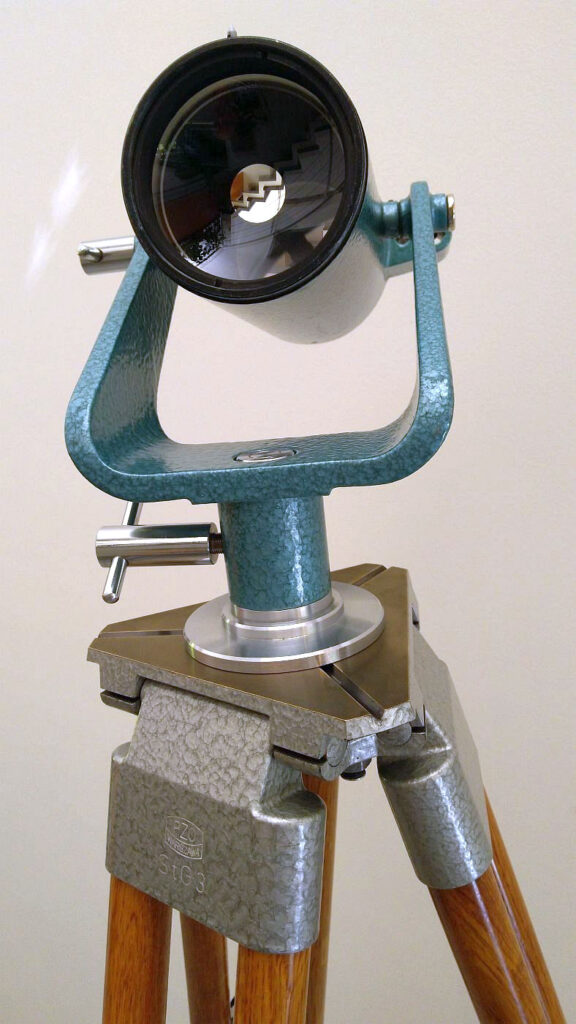
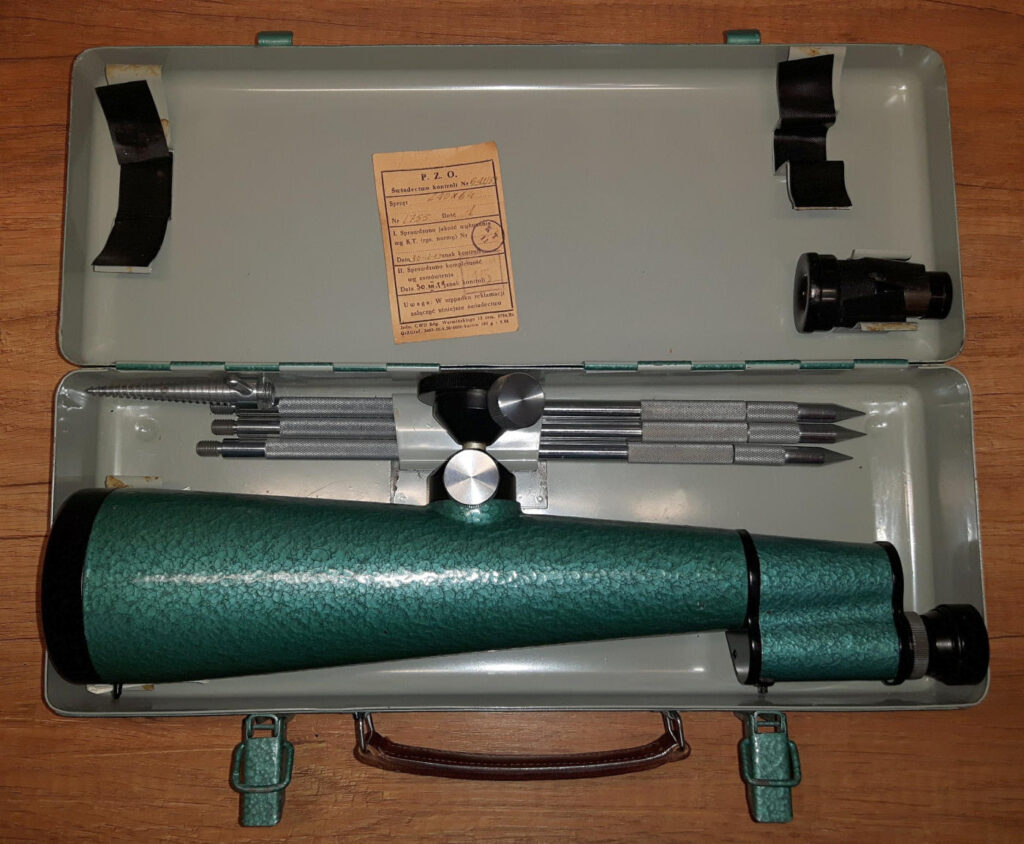
The school Mak’s origin history
The end of the 1950s was a period of intensive modernization of the machinery at the Polish Optical Works (Polskie Zakłady Optyczne – PZO). The new devices had to meet, among others: obligations arising from a large export contract with the People’s Republic of China. It was at this time that the technology of protecting mirror surfaces with a layer of silicon oxides was implemented at PZO. This opened the way to the production of a reflecting telescope meeting modern requirements, and many instruments created at that time have retained their optical efficiency to this day.
One of such products came to me after years of service in the school physics laboratory, and then after a forced „holiday”, probably spent in the basement or attic. This is a typical scenario – most of the examples that have survived in Poland to this day have been withdrawn from schools. I will soon devote a separate post to my „turquoise find”, but for now I will limit myself to presenting a few photos.
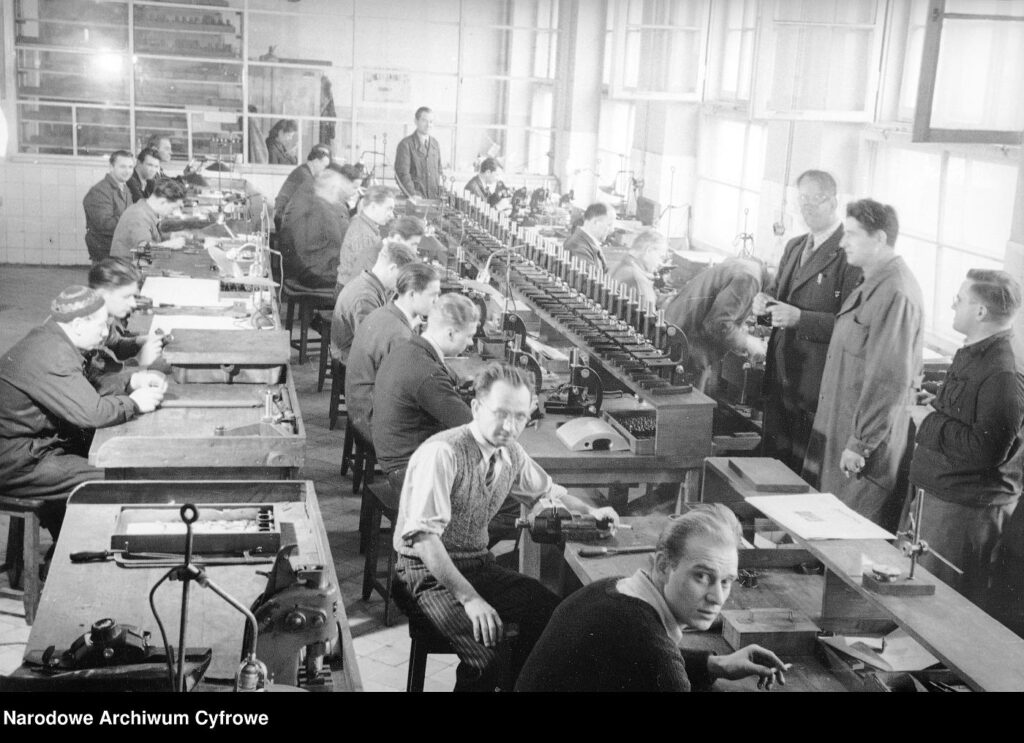
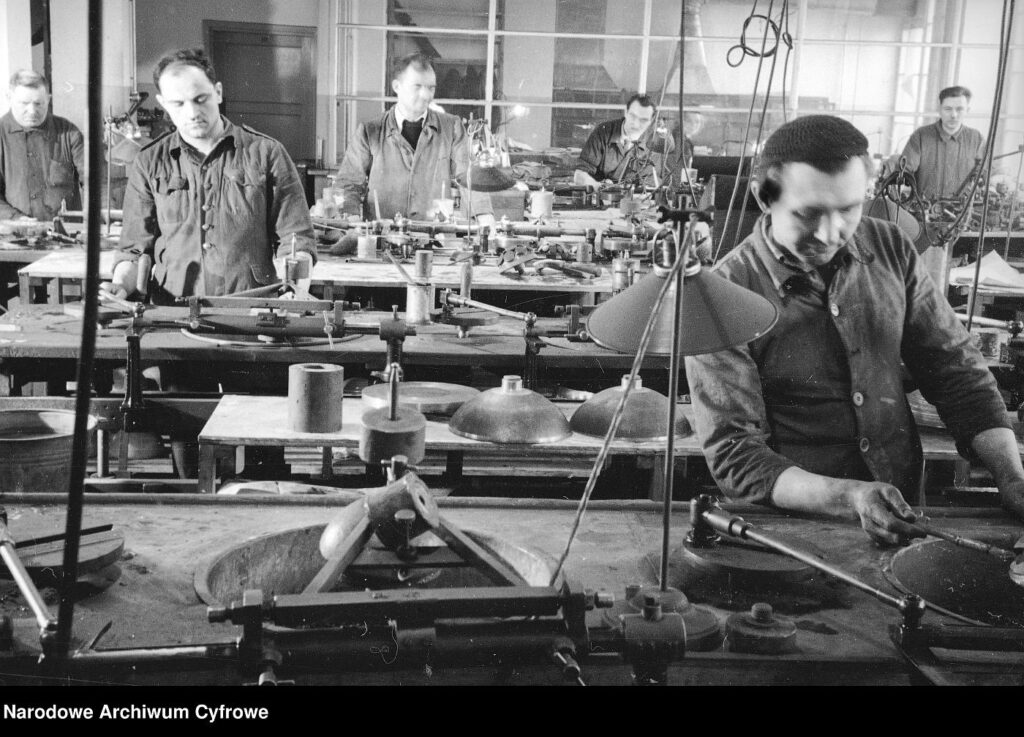
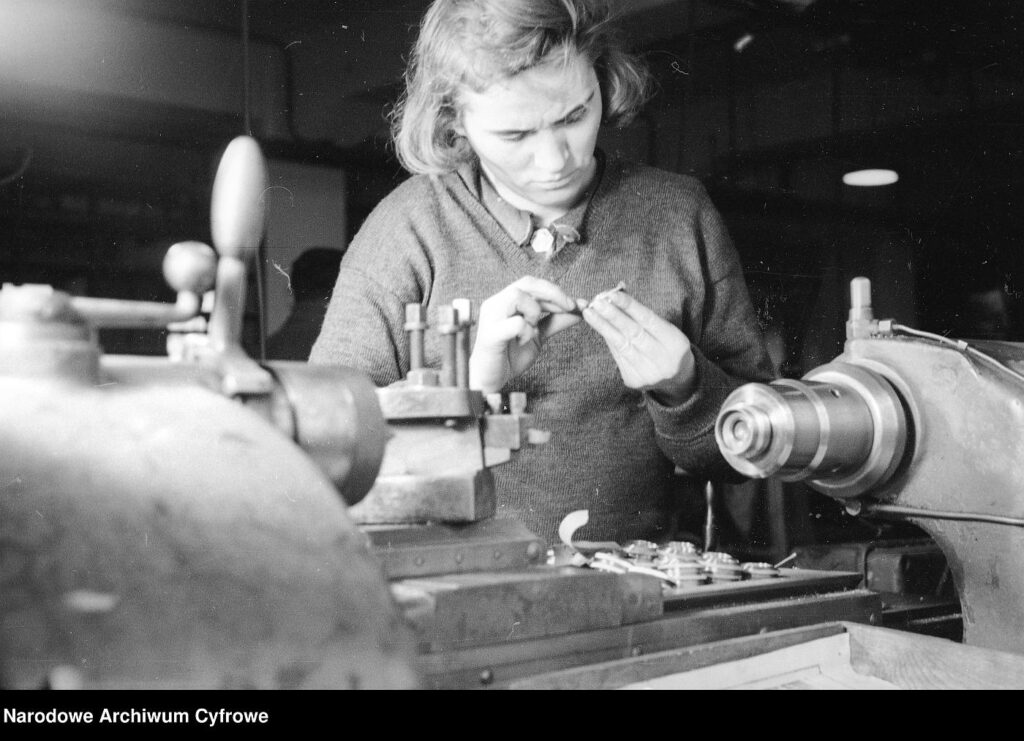
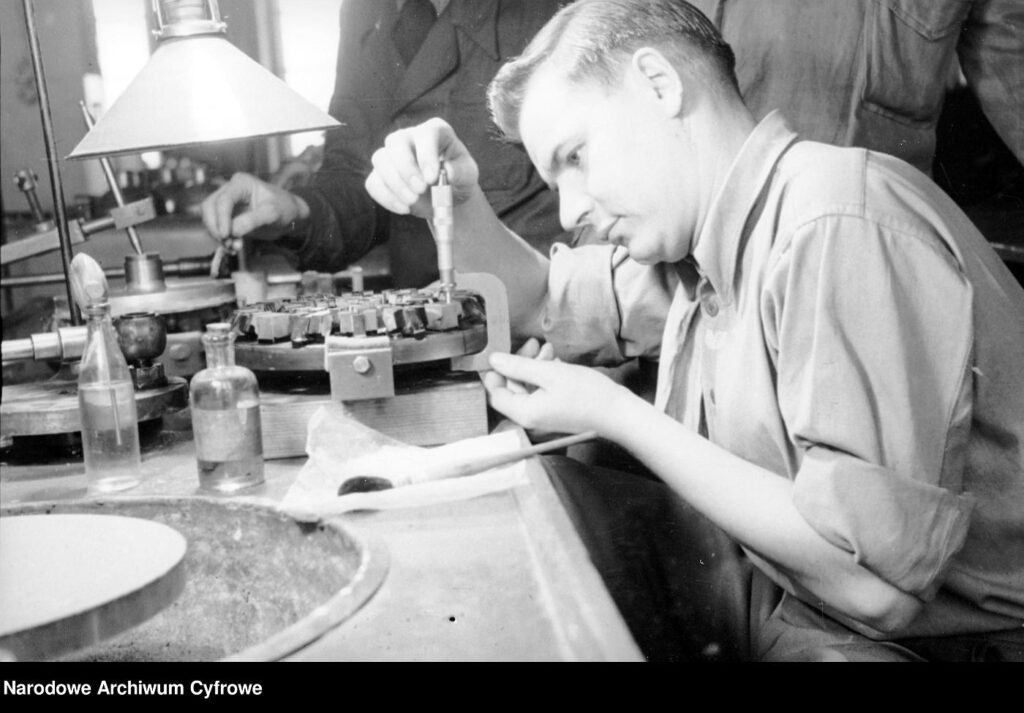
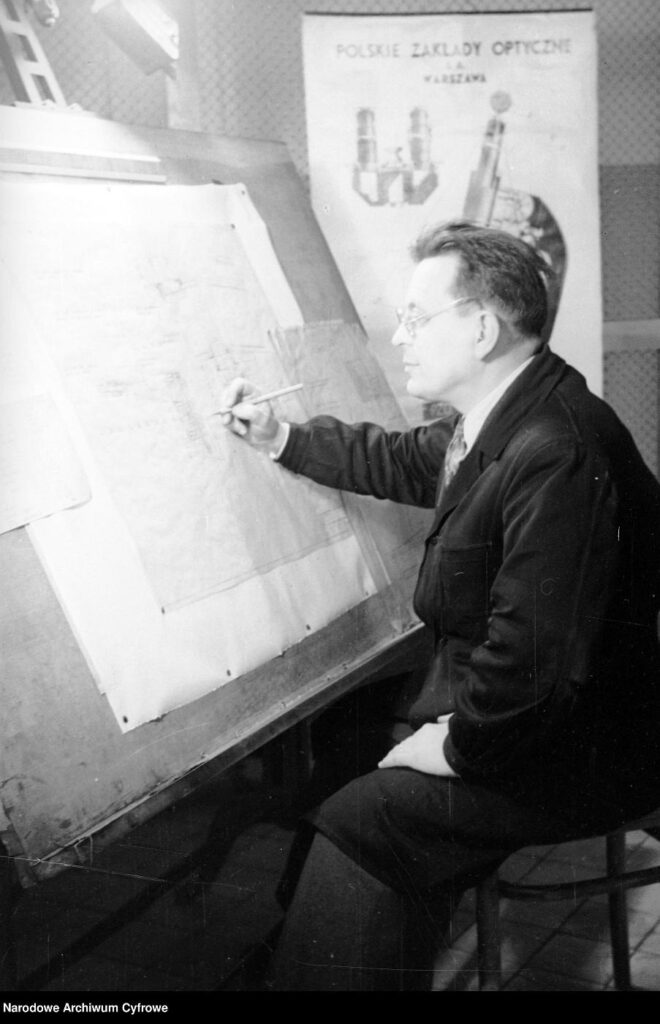

T50x70 is a model designed in 1958 by Janusz Olczak and Janusz Niewiadomski. Taking advantage of the Maksutov system allowed to minimize the size of the instrument. 70 mm of the primary mirror diameter and a focal length of 765 mm (f:11) fit into a compact tube with a length of just over 18 cm/7” (23 cm with the eyepiece) and a diameter of approx. 8.5 cm/3,3”. The first units of the reflector began to leave the PZO plant, probably as early as 1959.
PZO’s production plans were announced in the June 1958 issue of „Urania” (the monthly magazine of the Polish Society of Amateur Astronomers – PTMA), however, dispelling hopes regarding the availability of the instrument. In Antoni Piaskowski’s text we read:

– The main purpose of this article is to provide PTMA members with the following telescopes with objective lenses of 70 or 64 millimeters in diameter, as they will be produced only to order of specific institutions and therefore will not be put on the market for free sale (this applies in any case to the meniscus telescope „T 50X70”). However, if there were a sufficient number of people among the readers of „Urania” willing to purchase these tools, it is not impossible that PZO could be persuaded to produce an additional number of these telescopes. Therefore, potential applicants are asked to send their applications as soon as possible to the address of the Warsaw Branch (of PTMA – editor’s note) (applying directly to PZO is pointless).
Was the effort successful? We find a mention of this topic in the December 1961 issue of „Urania”, in which Piaskowski writes:
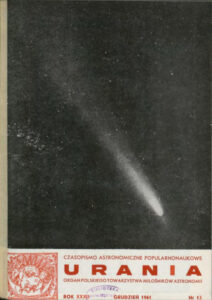
– Currently, the above tools have been on the market for a long time, and Maksutov telescopes can be purchased for 2,560 Polish Zloty (without a tripod) in the stores of the School Supply Storehaus „Cezas”. When it comes to starting the production of these telescopes, it is worth noting a certain role of our Society. The order collection campaign undertaken by M.A. Drojanowski, both among PTMA members (36 units) and among relevant institutions, led to collecting a sufficient number of applications to make the start of production profitable enough.
The situation may seem unclear. The telescope deliberately remained beyond the reach of individual customers, even though the price was elevated to 2,560 Zloty (without a tripod…). Quite a lot – considering that in 1961 the average monthly salary in Poland was 1,625 Zloty! And yet the manufacturer had to be „persuaded” through official organizations to produce and sell additional instruments to PTMA members…
A thousand telescopes for a millennium?
Commercial and sales goals apparently remained beyond the manufacturer’s scope of interest – even despite the commercial success of this model abroad. It’s hard to believe that it was taken into account from the very beginning, since the designed eyepieces did not meet the 0.965″ standard, common in Western countries (more on this in a moment). It may seem that thinking about economics was limited to simplifying construction and minimizing production costs.
While noting the resulting shortcomings, let’s remember one thing: the main advantage of the T50x70 was that it went into production at all! Taking into account the economic and political situation of Poland at that time, devastated as a result of the war and German occupation, and then subordinated to the production needs of the Soviet military machine, pushing the idea of producing a telescope for astronomy enthusiasts could seem a completely unrealistic whim – but it worked! The economy and simplicity of the design should not be surprising – especially in the case of an instrument intended for school use. Years later, they even turn out to be an advantage, thanks to which many of the examples preserved to this day can boast full efficiency and functionality.
So what was the real genesis of the T50x70?
In 1958, when the concept of telescope production was taking real shape, the „Thousand Schools for the Millennium” program was just starting in Poland, as a response to the post-war wave of baby boom. It was intended to add splendor to the celebration of the 1000th anniversary of the founding of the Polish state in 1966 by opening a thousand new schools. At the same time, the program served as a kind of propaganda counterweight to the „competitive” celebrations of the millennium of the baptism of Poland organized by the Catholic Church. As it often happened in the communist times, the program also had an additional catch – hidden paramilitary goals. The new buildings were designed and equipped so that in the event of war they could be easily converted into a network of makeshift military hospitals.
There was little time. The political pressure and the economic as well as organizational challenges associated with this project were gigantic. The facilities, built according to innovative architectural standards, required huge amounts of equipment… Classic conditions conducive to corruption and abuse!
However, in the conditions of „real socialism” it was slightly different. Private business potentially interested in parasitizing public investments did not exist. Instead, strong pressure created the opportunity to „smuggling” and implementing ideas that would normally have no chance of realization. Was the launch of T50x70 production an initiative of the authorities resulting from the needs of this program? Or maybe it was the opposite – engineers from PZO saw it as an opportunity and a pretext to convince political decision-makers to start producing the instrument, that night sky lovers had been waiting for?
We will probably never know this, nor will we know how many copies were produced in total (if I interpret the serial numbers system correctly, it could have been about 5,000), or what percentage went to schools and what percentage went abroad. Ultimately, over 1.4 thousand schools were put into use under the program and many, perhaps most of them, were equipped with the PZO meniscus telescope.
However, the modest scale of PZO production was a drop in the ocean of the education system’s needs. The social school construction fund continued to finance investments also after 1966. In total, until 1971, nearly 2,800 schools were built. This represented only approximately 10% of primary schools operating in Poland at that time. Even if all of them had been equipped with the T50x70, it remained a rarity in an average Polish school. In my primary school no one had probably even heard of such an instrument. Meanwhile, most of the instruments that did not reach classrooms were sent to the West. Night sky lovers in Poland were left with nothing.
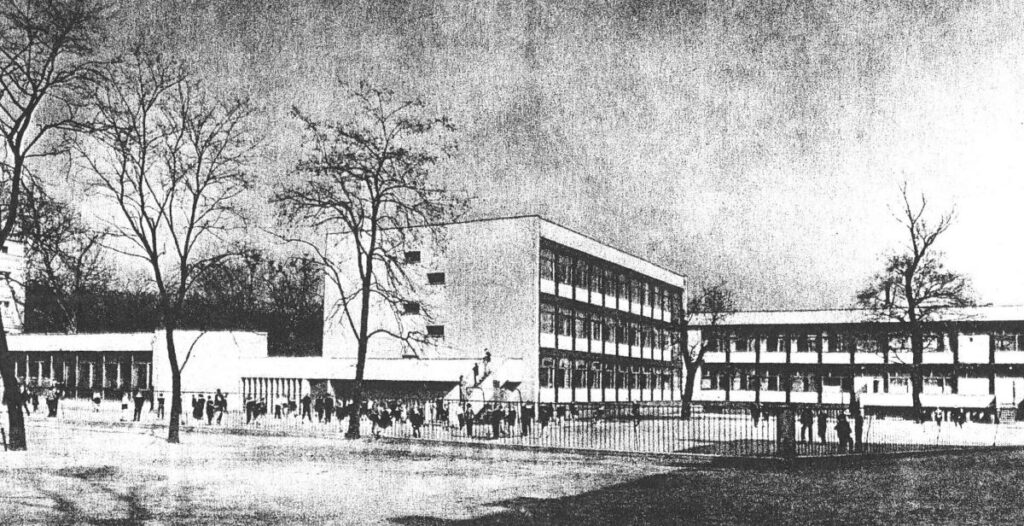
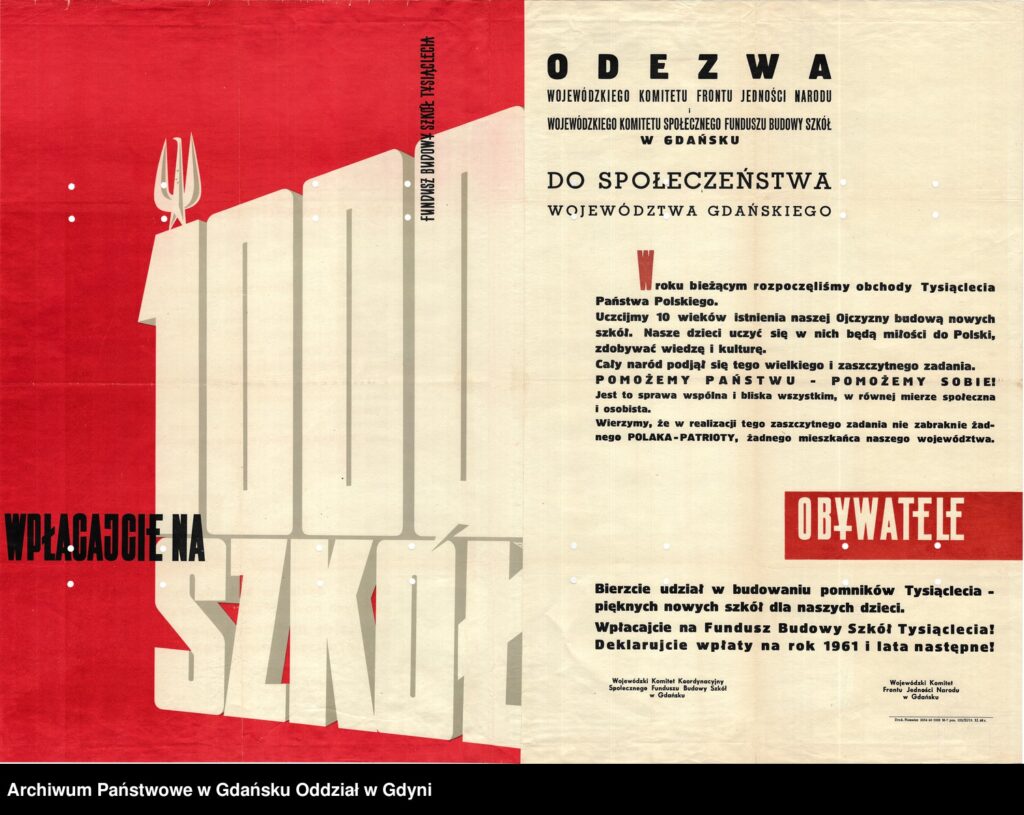
Lone meteor
Let us return to the action described by „Urania” and note that it was not the only example of this type of „negotiations” with PZO. In later years, PTMA managed, for example, to „persuade” the manufacturer to release a batch of excellent 67×800 mm achromatic lenses, designed especially for members of the Society. In the 1980s, I was one of the lucky ones who received such an achromatic doublet along with the PTMA ID card and organizational badge, which was the starting point for building my first DIY telescope!
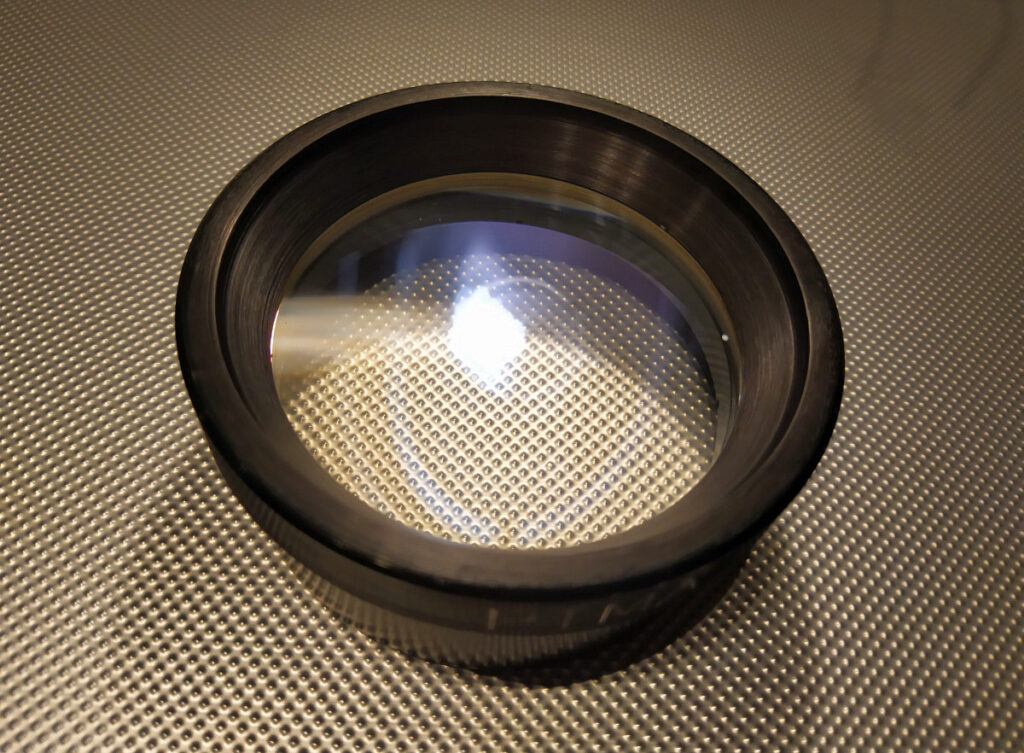
The reason for organizing such actions was simple: in communist Poland, the market for astronomical equipment did not exist. In photo-optical stores you could occasionally „hunt” good quality PZO binoculars, perhaps the above-mentioned L40x64 spotting scopes were sometimes available for retail sale. However, astronomical equipment was unavailable. It was neither produced (except for the T50x70) nor imported from abroad – not even from „fraternal” socialist countries. The restrictions also applied in the GDR, where Zeiss Jena produced great astronomical instruments, but they were only available to state institutions. However, during trips to the GDR, you could count on the opportunity to buy Zeiss accessories, such as eyepieces, filters or Barlow lenses. But what to mount them to?
One of the few options at that time was to grind the mirror yourself and build a reflecting telescope. At that time, I joined the group of desperate people who turned their apartment into a grinding workshop, but I lacked the determination to get through the polishing stage. After grinding, the mirrors ended up in a drawer, never seeing the First Light.
The T50x70, which appeared in Poland completely unexpectedly, had a chance to change this hopeless situation. Unfortunately – for some reasons, it disappeared as unexpectedly as a meteor over the western horizon. Most of us didn’t even notice it back then.
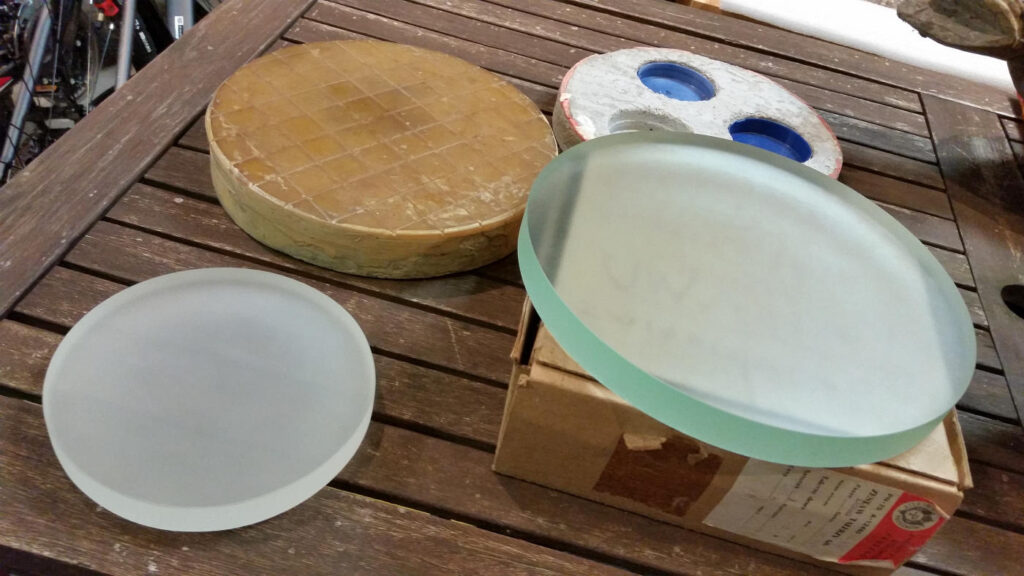
T50x70: the pros and cons
In order to simplify the construction, PZO engineers decided to use an unconventional focusing system. The seemingly brilliant idea, however, led to far reaching consequences, resulting in troublesome limitations of the instrument.
Modern Maksutov or Schmidt-Cassegrain systems take advantage of a focusing mechanism based on a movable primary mirror. It provides a very wide focusing range, although it can be capricious. Users often supplement it with an additional focuser, which allows for greater precision in sharpening and avoids the effects of wear of the components that move the heavy mirror.
Focusing range
The designers of the T50x70 reached for an extreme solution – and completely deprived the telescope of the focusing mechanism. The primary mirror is stationary and there is no external focuser. Instead, it was decided to transfer the focusing tasks to the eyepieces. They are equipped with a multi-thread collet, allowing for a small range of movement of the eye lens. This solution is used in binoculars, which usually have a much shorter focal lengths.
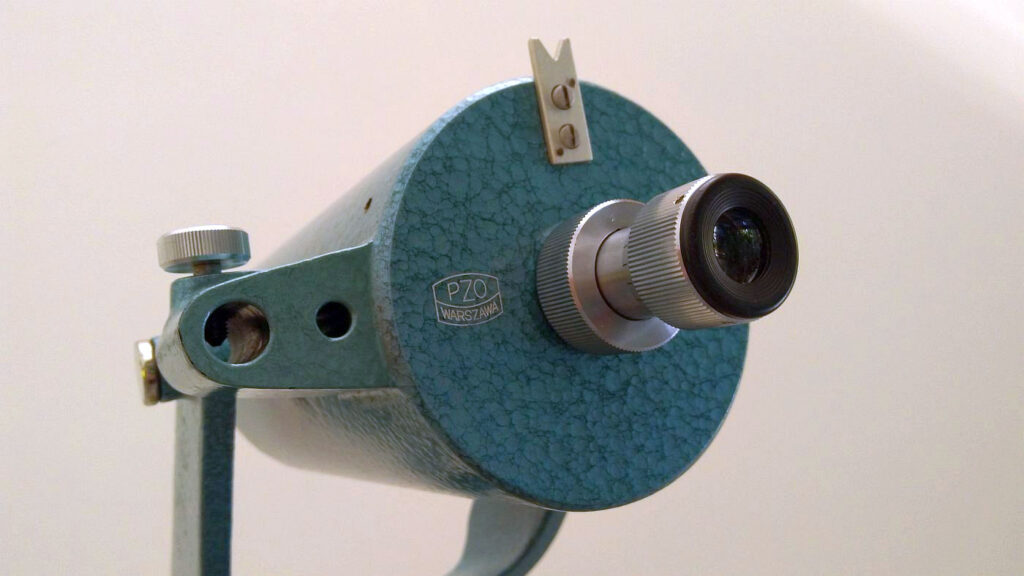
The limited range of movement of the eye lens grants the correct image of distant objects, but makes it difficult to focus at closer distances, forcing to risky maneuvering the position of the entire eyepiece. When we take into account serious problems with reflections (described below), it turns out that the version I tested is limited to astronomical applications. The telescope is not suitable for terrestrial observations.
Accessories
The sharpening method used in the T50x70 means that the eyepiece becomes an integral part of the telescope. Limiting the range of accessories to dedicated eyepieces turned out to be one of the most serious shortcomings of the instrument. Users were provided with two factory-delivered eyepieces:
| Focal length | Magnifying power | Exit pupil | Field of view | Resolving power |
| 15,33 mm | 50x | 1.4 mm | 42′ | 2” |
| 8,31 mm | 92x | 0,76 mm | 34′ | 2” |
The first one is most likely a 4-lens symmetric eyepiece , with a design that effectively reduces chromatic aberration. The second one is, according to the manufacturer, a 5-lens orthoscopic eyepiece .
Despite the good quality, the design of the eyepieces raises another problem resulting from the non-standard, 17-mm barrel size. Even if we agreed to a makeshift method of sharpening by manually maneuvering the eyepiece in the mounting sleeve, it would not be possible to use either eyepieces with the 0.965″ standard common at that time, or even microscope eyepieces with a diameter of 23.2 mm produced by PZO. Or maybe at least eyepieces from the L40x64 spotting scope, based on a similar design…? I must dispel these hopes: they do not fit! Although it is difficult to understand today, very similar eyepieces made for L40x64, introduced at the same time, differed in the barrel diameter (20 mm) – still not meeting any standards!
We understand, of course, that this type of absurdity was the price paid for breaking away from free market mechanisms, that verify ideas and decisions made at the desk. On the other hand it must be admitted with some regret, that at the same time, German comrades in the GDR decided to follow the „Ordnung muß sein” rule. Zeiss Jena honored the 0.965″ standard, which still pays off today.
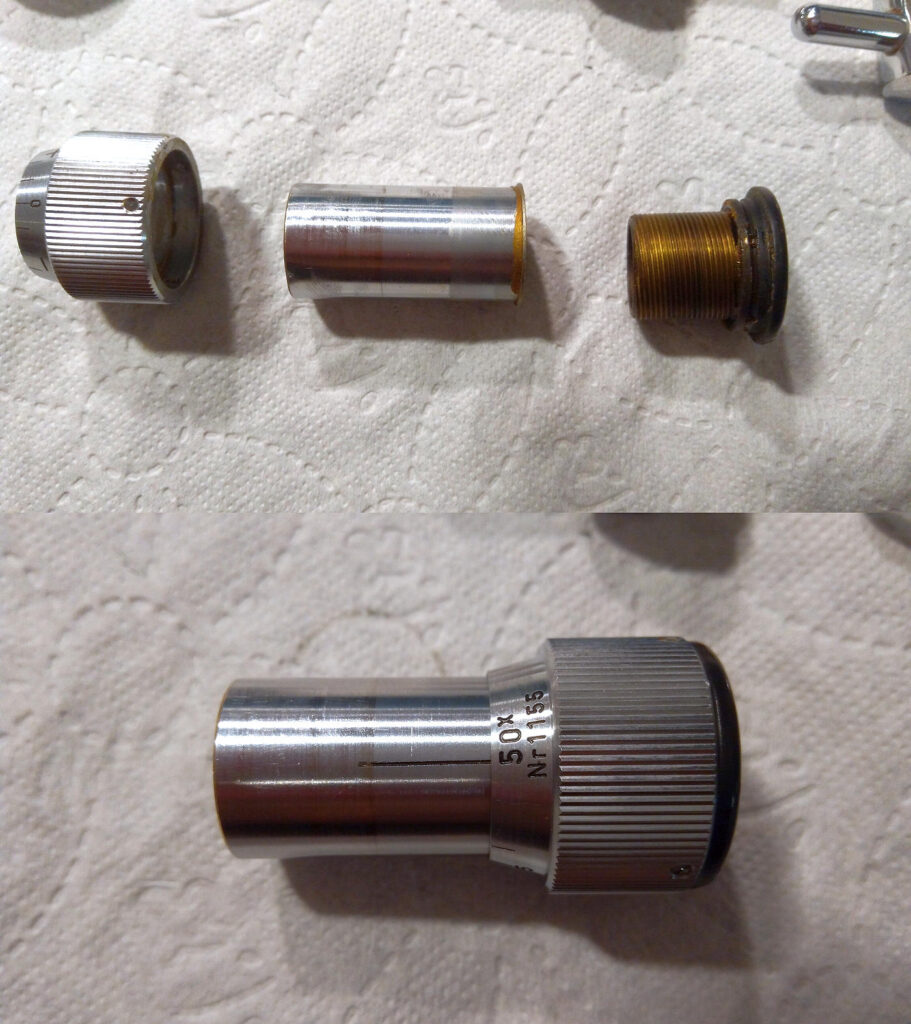
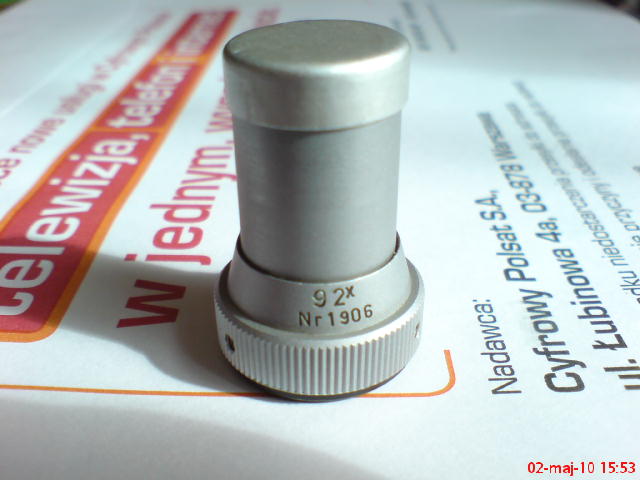
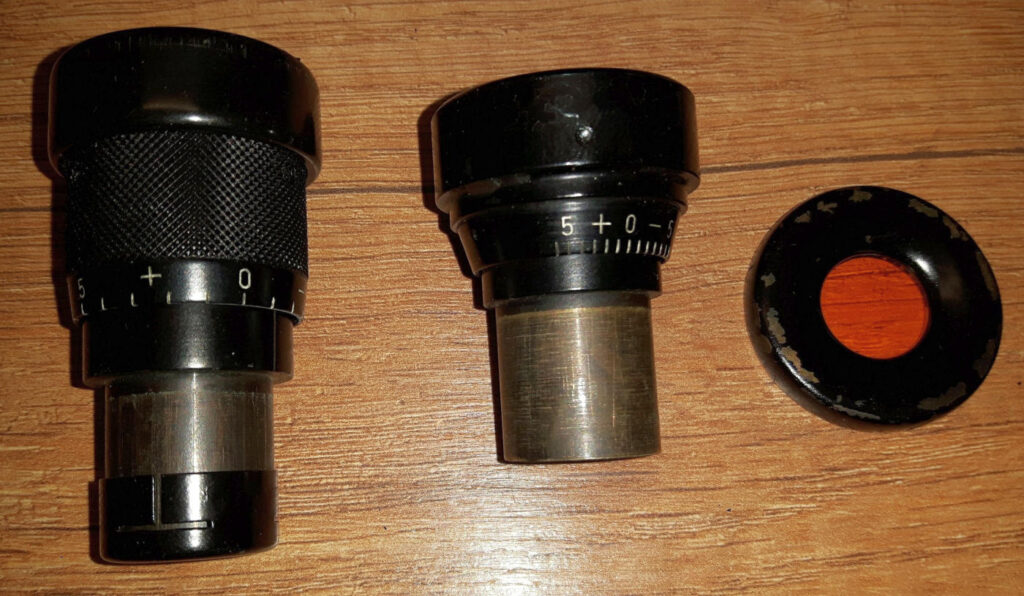
Speaking of accessories, it is worth praising the manufacturer for the fact that the T50x70 was equipped with a 15×15 cm solar projection screen. The ability to move it along the telescope axis allowed, by maneuvering the eyepiece, to obtain the same linear size of the solar disk, regardless of changes in its angular size during the year. In schools, observing the Sun using a screen and making sketches was one of the basic uses of the telescope.
The full set of accessories included:
- 2 eyepieces mentioned above
- solar screen
- meniscus cover
- a second cover with a hole that reduces the aperture for solar observation
- a brush recommended by the manufacturer for dusting the meniscus (perhaps only in export versions)
- flannel cleaning cloth (perhaps only in export versions).
The export offer also included optional accessories (at an additional cost):
- light table tripod (probably from the L40x64 spotting scope)
- adapter reducing a 20 mm thread to a photographic thread, allowing for mounting on a standard photographic tripod.
The simple design of the original version of the instrument did not include a finder, which was replaced with a regular front sight and rear sight. I wonder if the diagonal visible in some photos was an original element of the set. This possibility is indicated by the authors of the photos, but it is not clear how the manufacturer would have coped with extending the optical path by several centimeters and moving the eyepiece away from the focus in such a case.


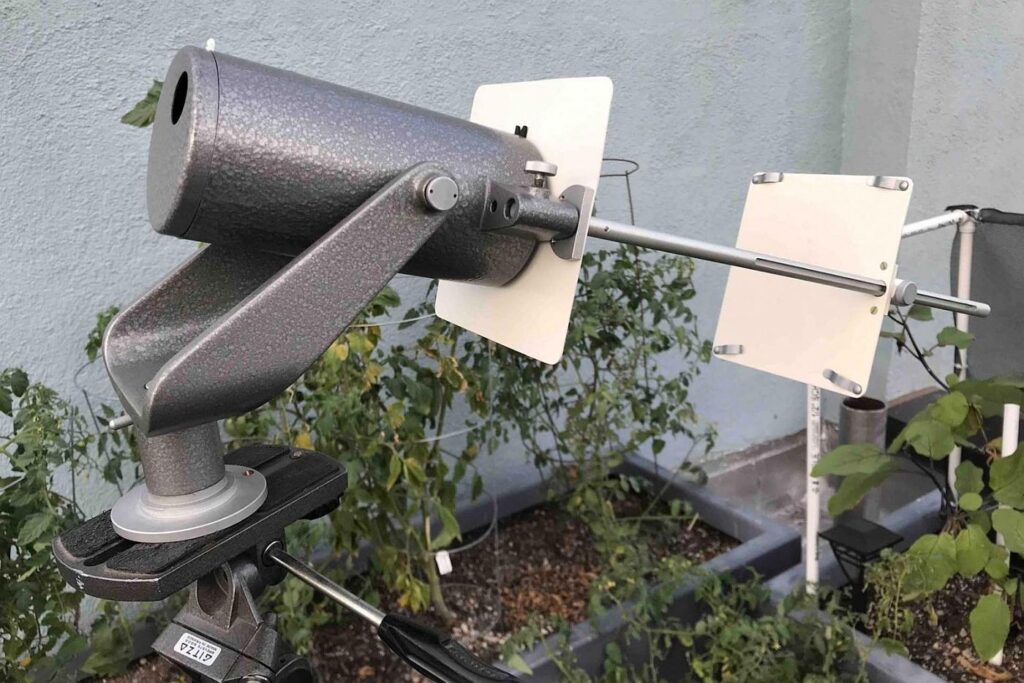
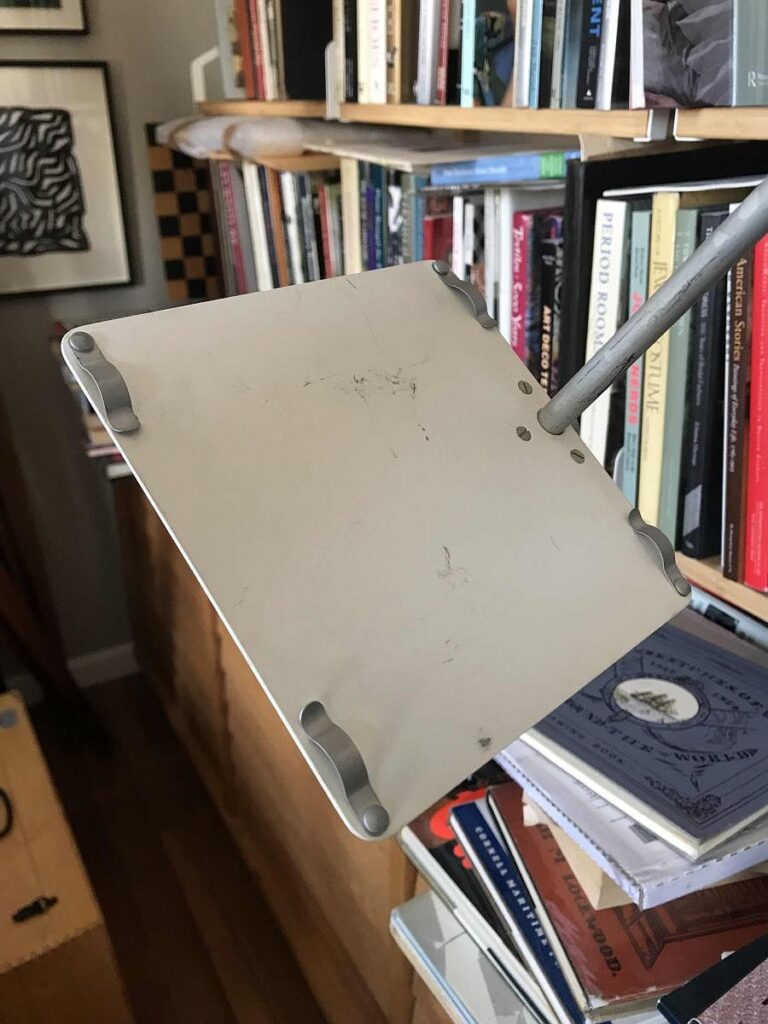
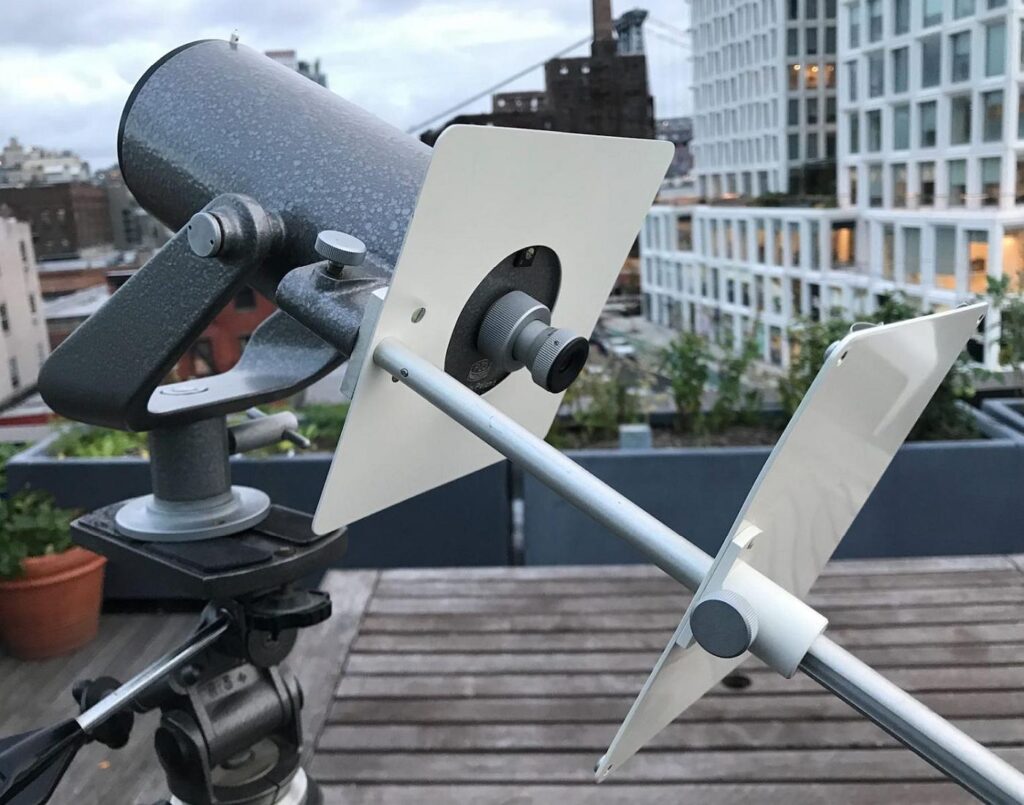
Durability of primary mirror coatings
Years later, it turned out that the technology for protecting mirror surfaces introduced in 1959 was not as durable as expected. Most T50x70 examples that have survived to this day show greater or lesser traces of peeling and detachment of the layers covering the primary mirror, and this is usually visible near the edge. Minor defects and damage do not noticeably affect the image. However, they herald a problem that, as it grows, may ultimately force the replacement of coatings.
It is worth noting here that mechanical detachment is not the only indication for their replacement. In the case of reflectors, we are dealing with a systematic decline in the optical efficiency of mirrors, even if their surfaces are in seemingly perfect condition. After a dozen or so years, this effect results in a noticeable reduction in image brightness – even in the case of optics produced today. In the case of an instrument with several decades of history, the need to replace coatings should not be surprising – regardless of the visual condition of the surface.

Image quality
Great planetary and lunar images – that’s why this model is appreciated. This is how it was advertised abroad, which is due to its parameters resulting in a relatively small field of view – typical for „planetary” instruments. It must be said that the eyepieces included in the set do not give a full picture of the telescope’s capabilities, as they do not allow for maximum reasonable magnification. A reflector of this diameter should allow to easily obtain magnifications exceeding 100 x, and in good conditions probably much more. However, using dedicated eyepieces, it’s possible to reach magnifications of up to 92 times (perhaps this was to ensure optimal conditions for observing the solar disk using a projection screen). In such conditions, the image (without traces of chromatic aberration) is of course impressively precise.
A rather serious drawback of this model – at least in the original school version I tested – are the reflections. The light beam is directed to the eyepiece through an unmatted sleeve, which is susceptible to this effect.
In the case of brighter stars or planets just outside the field of view, the reflections may take the form of round, luminous artifacts visible at the edge of the field. When observing bright objects inside the field of view (the Moon), light reflections from the sleeve become more visible, which surely reduces the contrast to some extent. The brighter, the worse: the effect of lower contrast, accompanied by a glow covering a large part of the image, is particularly severe in the case of daytime observations. Perhaps the designers decided that the telescope was not intended for such applications?
Mount and tripod
A simple, fork alt-azimuth mount is, like the eyepieces, an integral part of the telescope. It is equipped with a thread that fits geodetic tripods with a standard 20 mm mounting screw – such as the StG-3 or StG-4 models produced by PZO.
The mount offers no slow motion controls, but the well-balanced, massive and short tube allows you to maintain a stable position in the horizontal axis even with some loosening of the pressure screw. This provides quite good comfort for tracking objects. Thanks to the stability and precision of movement, the solution turns out to be more convenient in practice than many Japanese alt-az mounts of the time, even those equipped with slow motion controls.
The exemplar I received is equipped with a PZO StG-3 geodetic tripod and it is an original configuration intended for schools. The tripod is a good quality, simple (non-extendable), but solidly constructed structure that allows the instrument to be held at a height sufficient for observations despite the lack of a diagonal.
Some export versions were offered with a light metal tripod, probably adapted from the L40x64 spotting scope. Abroad, an optional 1/4”-20 mm adapter was also offered, allowing the mount to be placed on a photographic tripod.
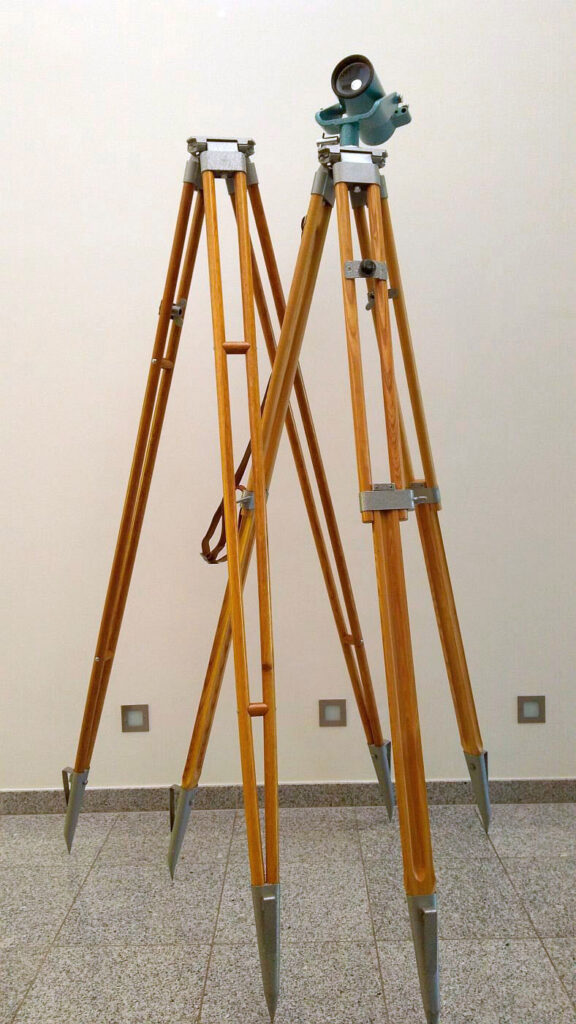
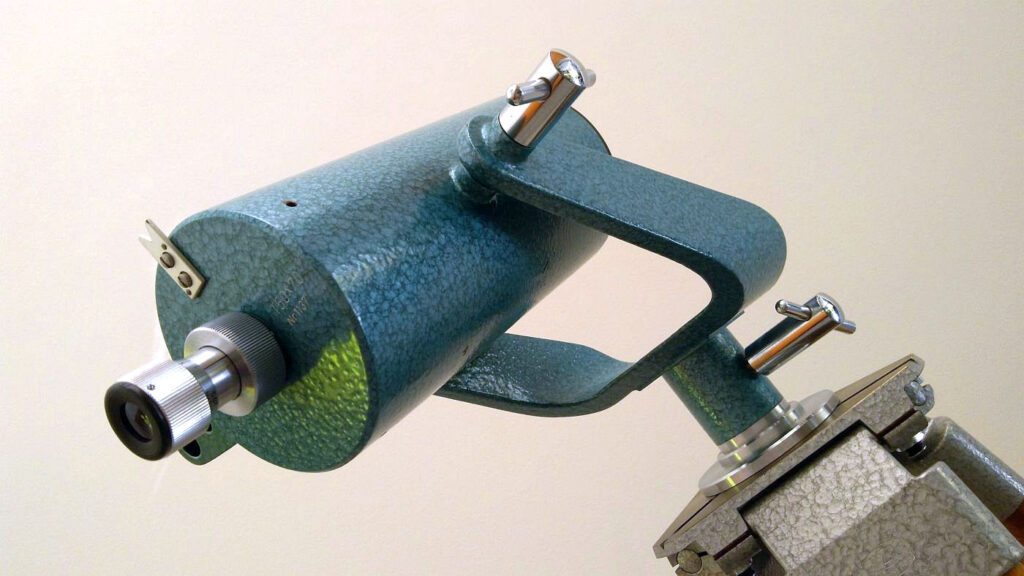

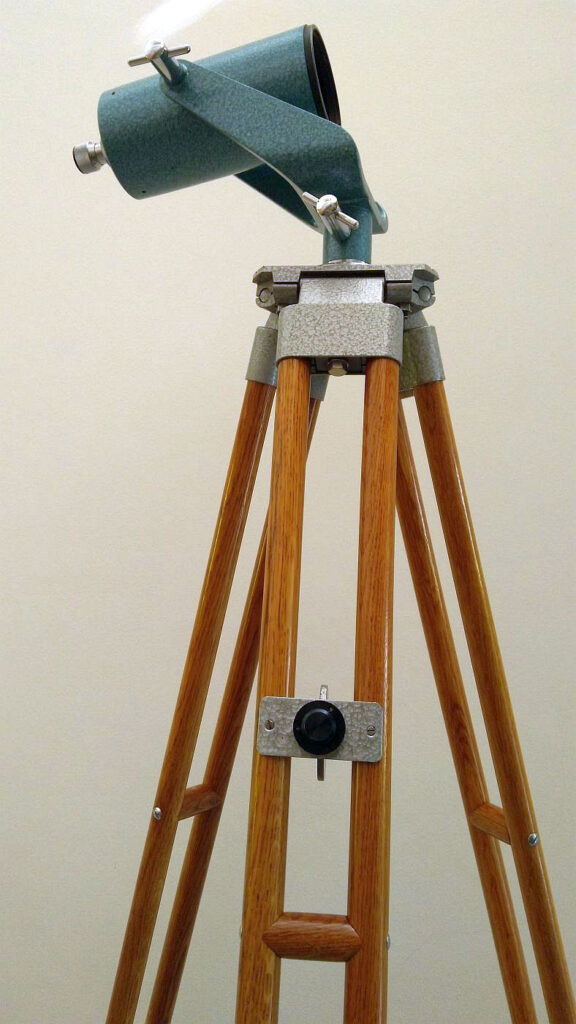
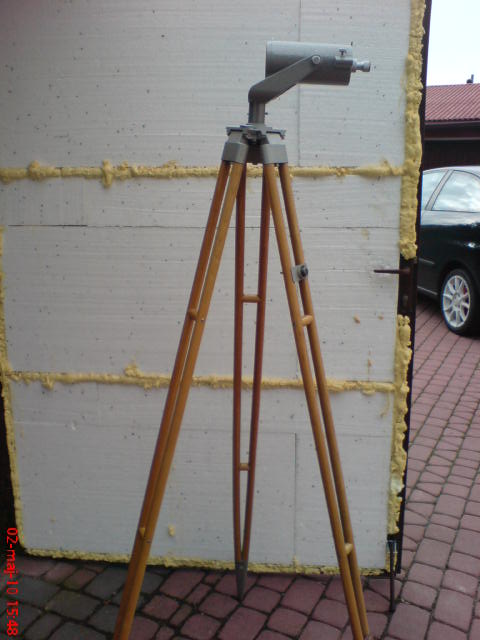
It turns out that StG-3 is currently experiencing a renaissance of interest in Poland – this time thanks to interior designers. The simple, non-extendable structure gives it an openwork, light appearance, contrasting perfectly with heavy stage spotlights. They are eagerly mounted on StG-3 and sold as designer retro lamps in a „loft” style.
Painting
The T50x70 examples documented in the photos indicate that this model left the PZO plants in three painting variants:
- hammertone turquoise
- hammertone dark gray
- textured cream with mount painted black
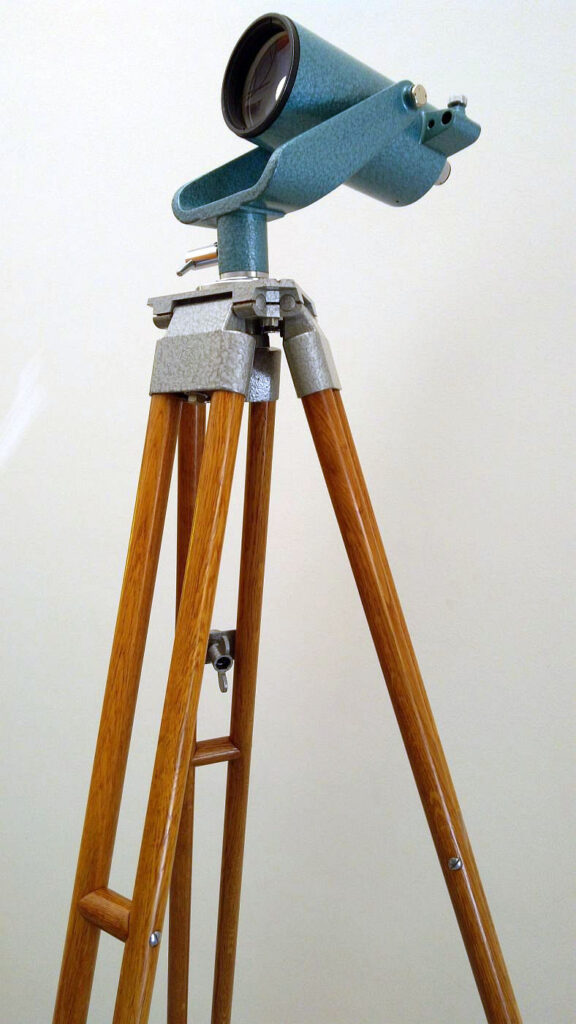
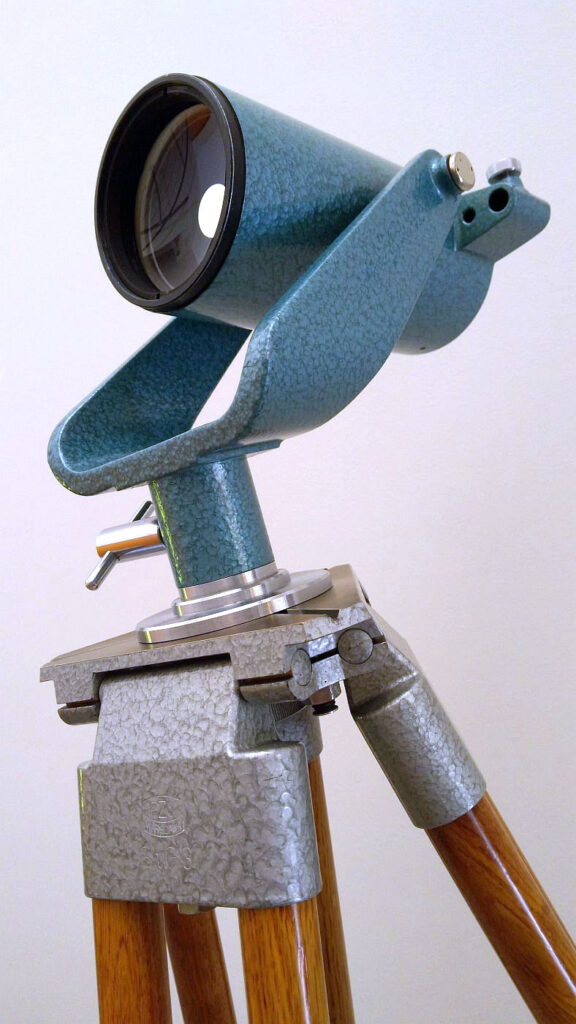
The original version was painted with hammertone varnish in turquoise or dark gray, usually very well preserved on the examples that still exist today.
Dark gray versions usually have higher serial numbers – probably appearing in the late 1960s and early 1970s. Galvanized or aluminum elements have a uniform, matte finish, resembling the surface of natural-color anodized aluminum. This also applies to eyepieces.

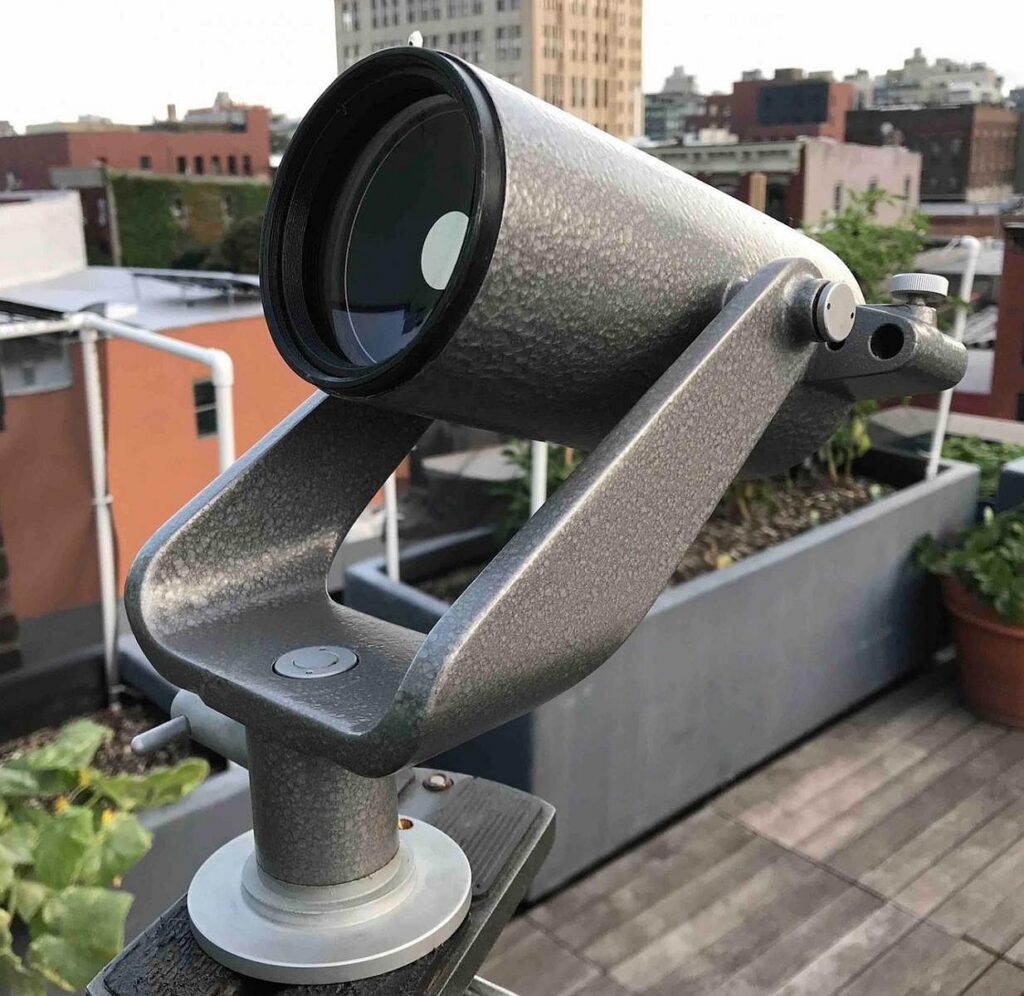
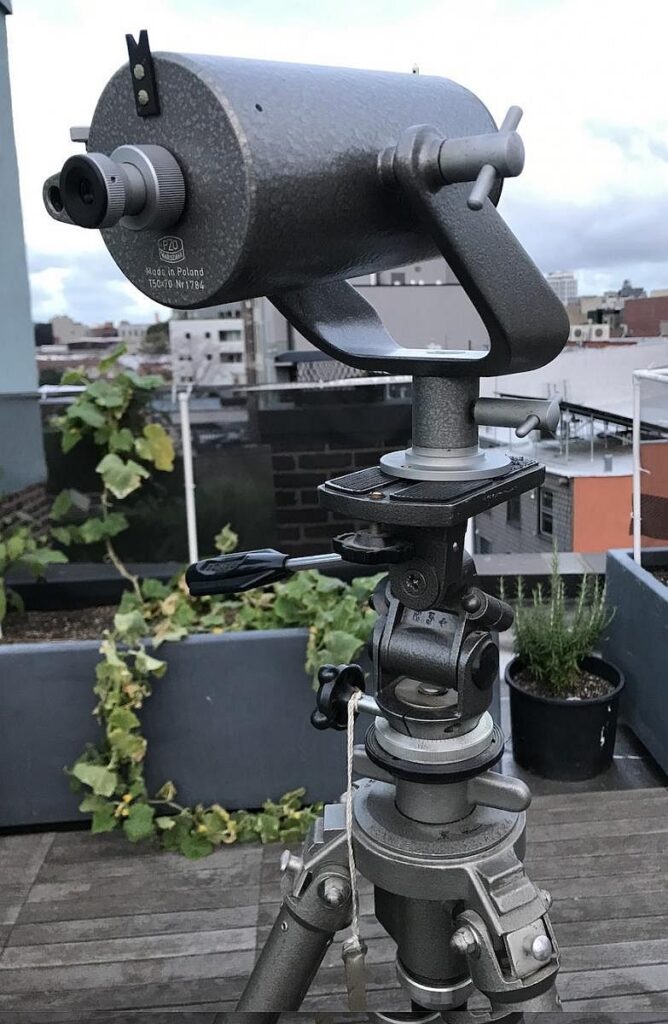

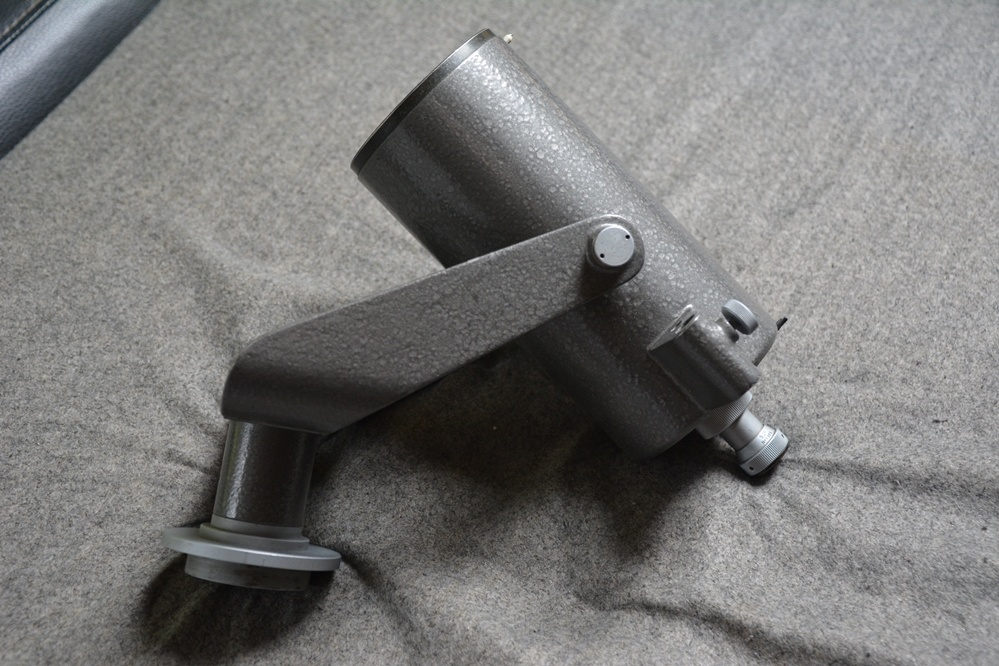
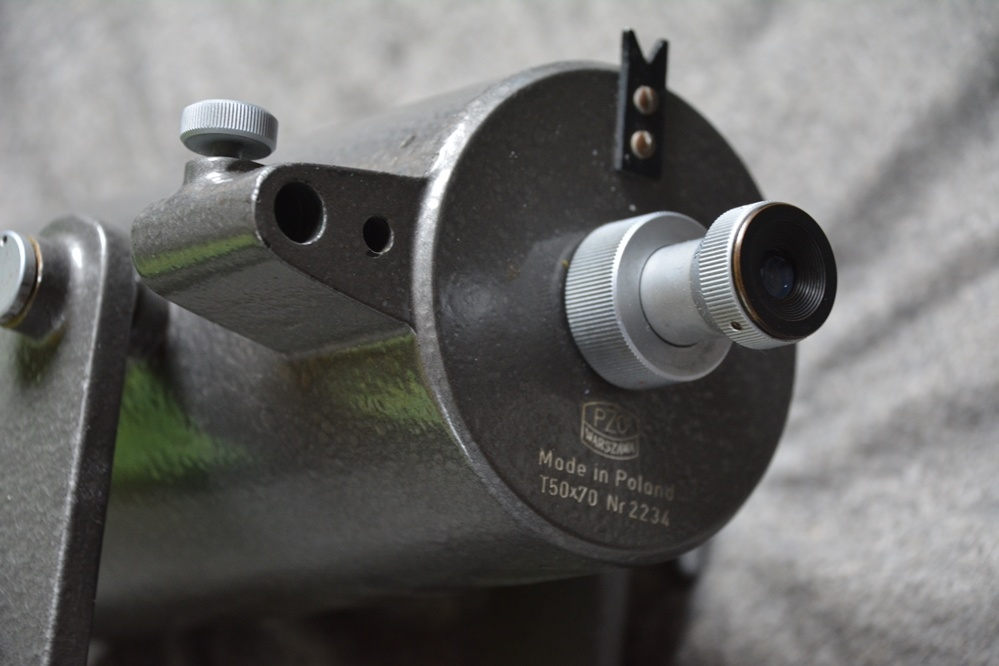
It seems that the homogeneous in color, textured varnish used on later copies from the 1970s, e.g. on the „Copernicus” export version, fare slightly worse. Cream-colored instruments covered with it – shades ranging from warm pearl white to tones of sandy beige – often show signs of loosening of the varnish layer, especially on the edges. In this variant, the mount was painted black, reminiscent of the black knobs of the pressure screws.
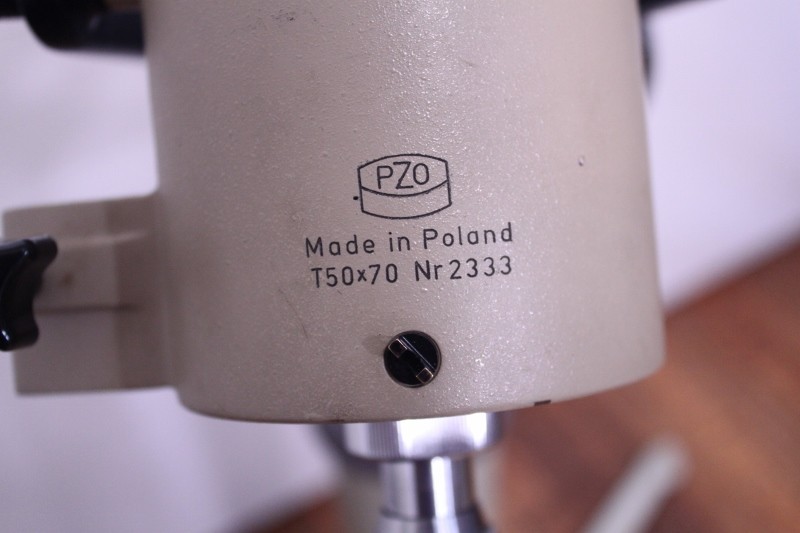
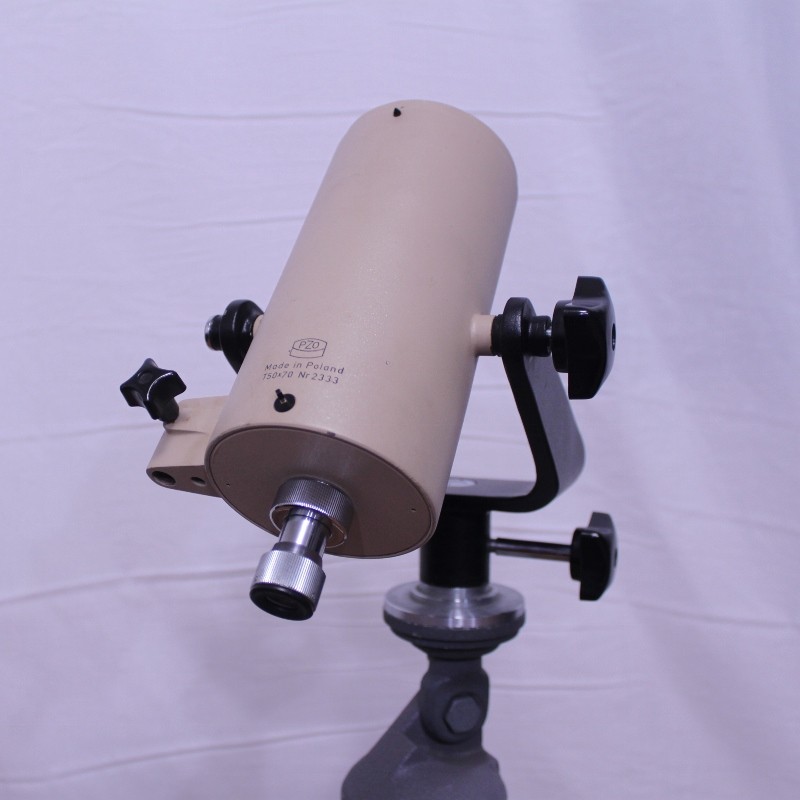
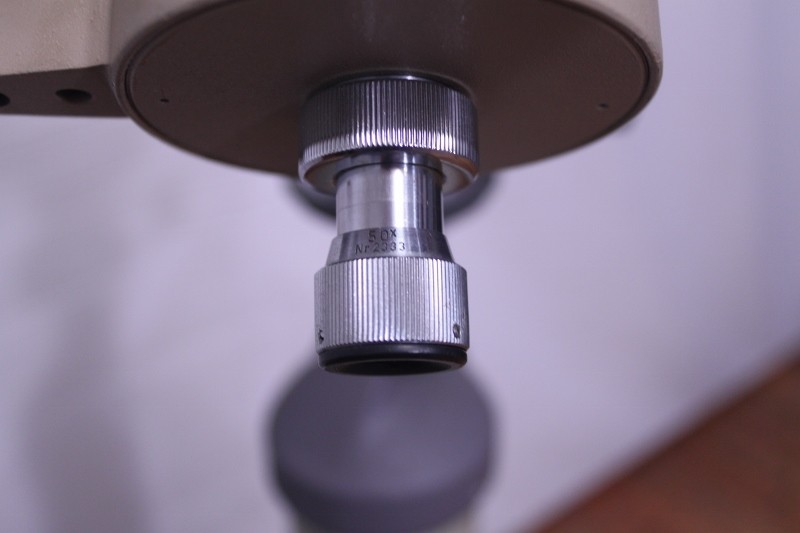
Variants, export versions
I do not have verified information about when the export of the T50x70 began or what markets it was targeted at. It was certainly offered in Great Britain and the USA. Sales abroad may have started soon after production began and probably lasted until the early 1980s. As for price, it seems to have hovered around $200-250 throughout this period.
At foreign auctions you can still find typical, „school” T50x70 exemplars, with the annotation „U.S.A.” in the „Retail price” section at the label. This proves that for some time the standard version of the telescope was also exported, packed in boxes made of thin plywood and covered with black bookbinding paper on the outside. At least this applies to the slightly later version painted in dark gray:


Celmak – 1960s
The first American advertisement that I managed to find comes from the November issue of Sky&Telescope from 1964. We see a T50x70 copy offered by Cell Optical Industries. The telescope, called „Celmak„, is equipped with a classic finder and a slow motion controls in both axes. This is probably an export variant only.
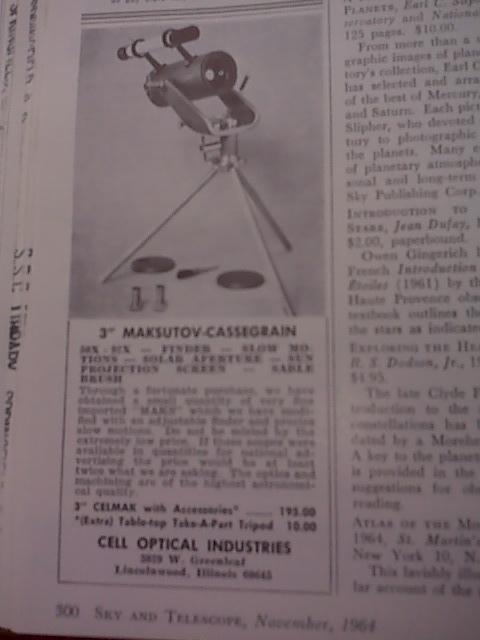
The instrument is mounted on a light, „table” metal tripod, which is probably an adapted tripod of the L40x64 spotting scope. There is an assumption, confirmed by a witness, that this version was factory equipped with a 90-degree diagonal made by PZO. Moreover, it looks consistent with the „school” original – also in terms of painting with hammertone varnish. Thanks to Steve from the CloudyNights.com forum, we can see unique photos of this variant:
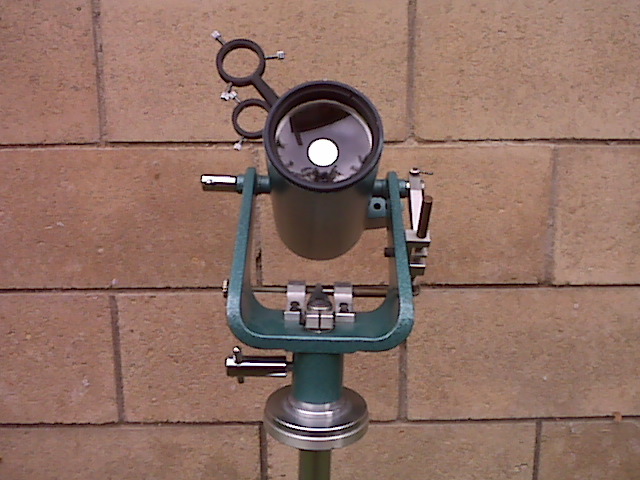
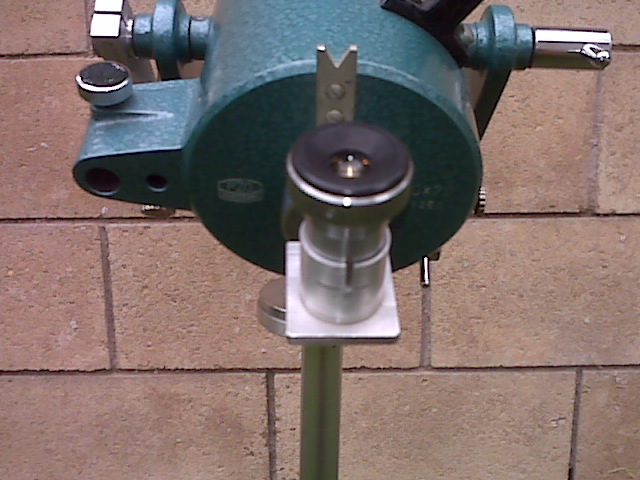
The „improvements” seem not only clumsy, but – considering the limited magnifications – above all, unnecessary. Especially stylistically alien, the large finder gives the impression of an element coming from another instrument, added a bit forcedly. They destroy the original charm of the simple, neat design, which was probably also noticed in PZO, which abandoned these additions later.
Copernicus – 1970s and early 1980s
A new version appeared in the 1970s. It was decided to stick to a simplified design without a finder and slow motion controls, making some stylistic changes. This variant, also present in Poland, was advertised abroad as „Copernicus Telescope” with the slogan „Optics from Kopernik country”. One source suggests that this version was created in 1973, on the occasion of the 500th anniversary of the birth of Polish astronomer, which would indicate a quite well-thought-out marketing strategy.
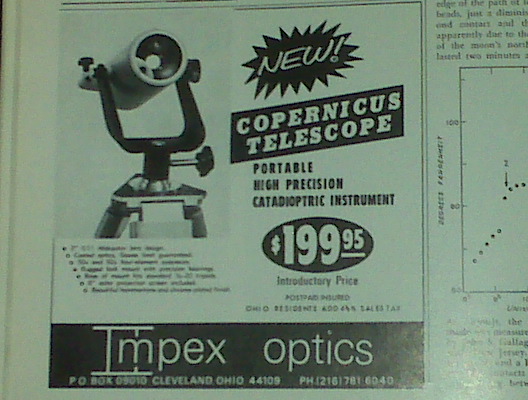


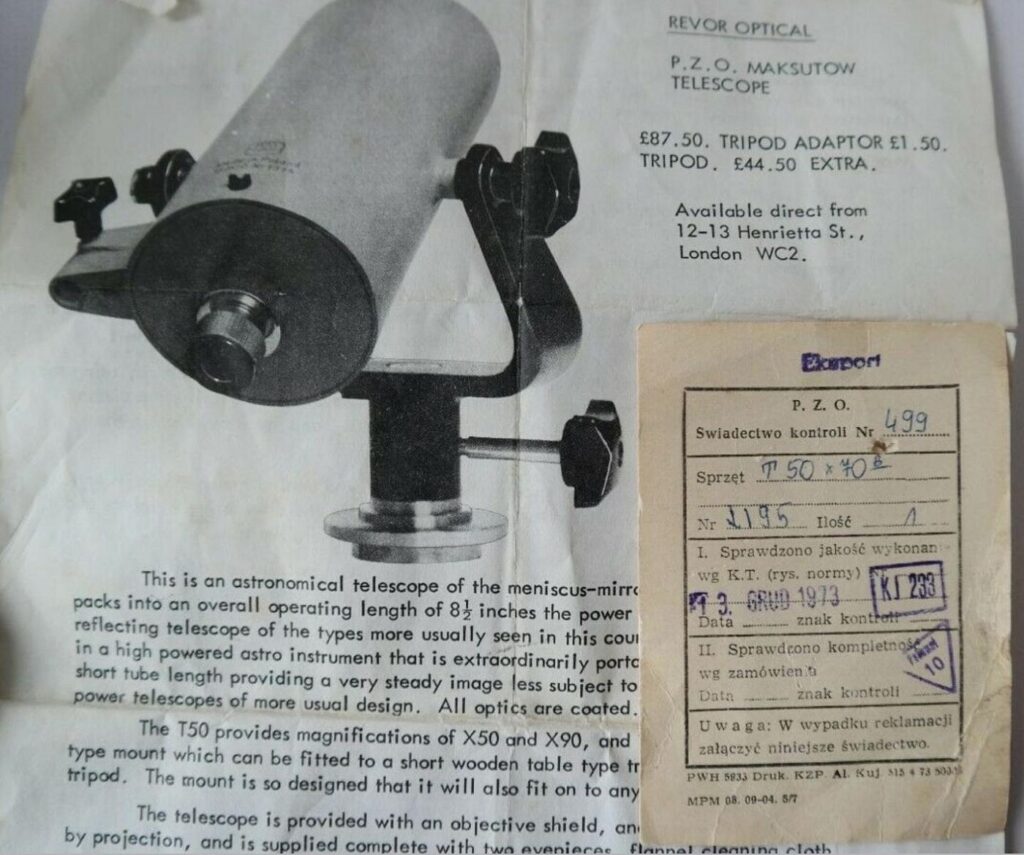
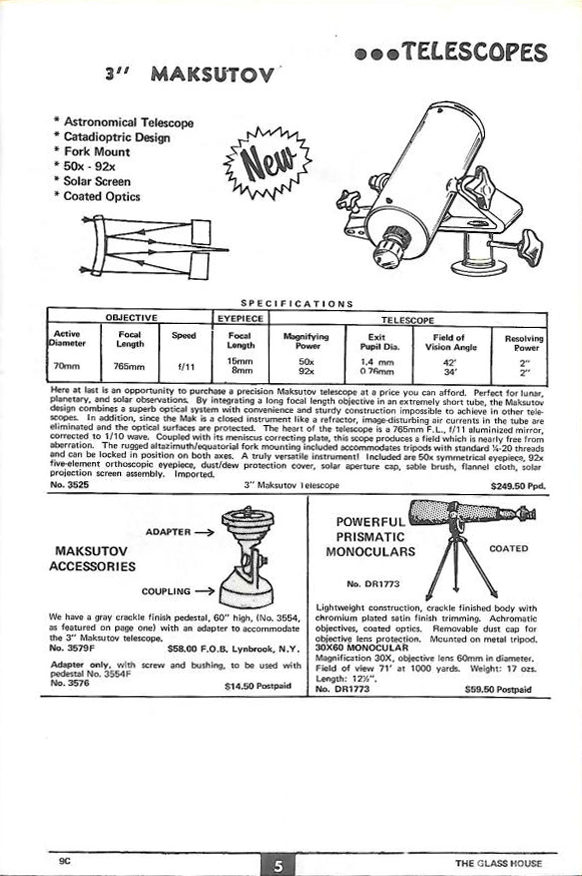
This model replaces the metal knobs of the locking screws with black plastic knobs, which match the black paint used on the mount. This time it was a simple and cheap, and at the same time quite successful „stylistic upgrade”, thanks to which the telescope took on an appearance matching the style of the 1970s. The appearance of the front sight and rear sight has changed, as well as the pressure ring securing the meniscus, which seems to be about twice as thick as in the original version (which must have resulted in the reduction of the active diameter of the meniscus). The whole thing was complemented by decently designed packaging with the image of Nicolaus Copernicus, intended for foreign markets. In Poland, the telescope was still delivered in a black box with a modest label, this time made using purely bookbinding techniques, without the use of plywood.


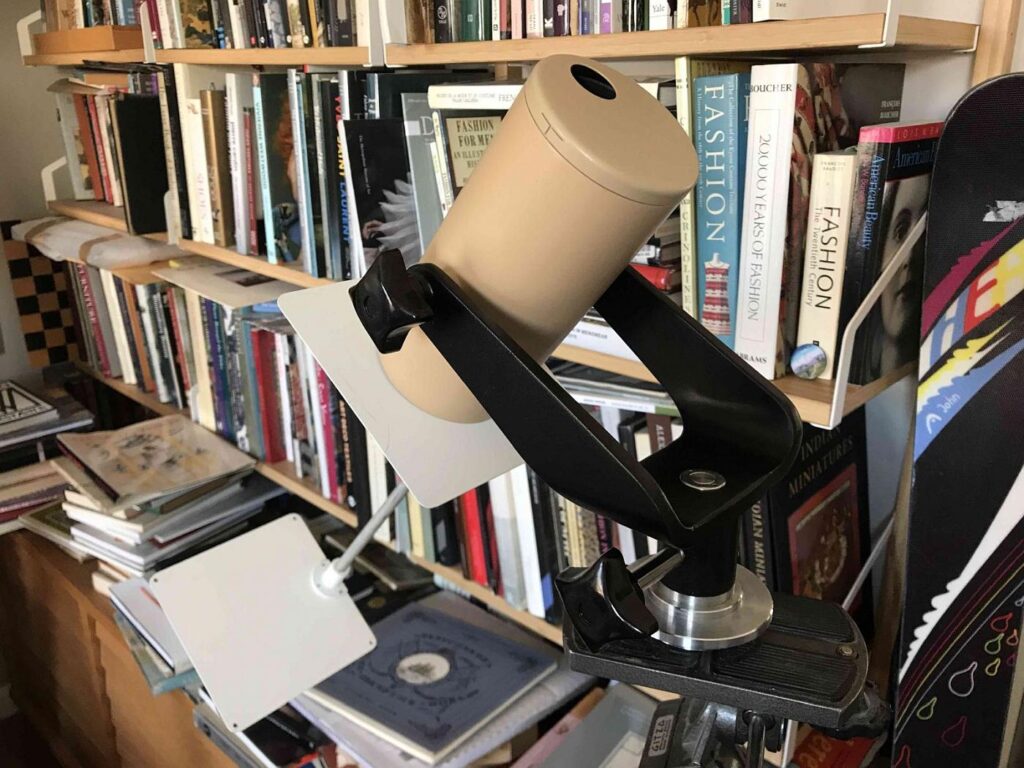
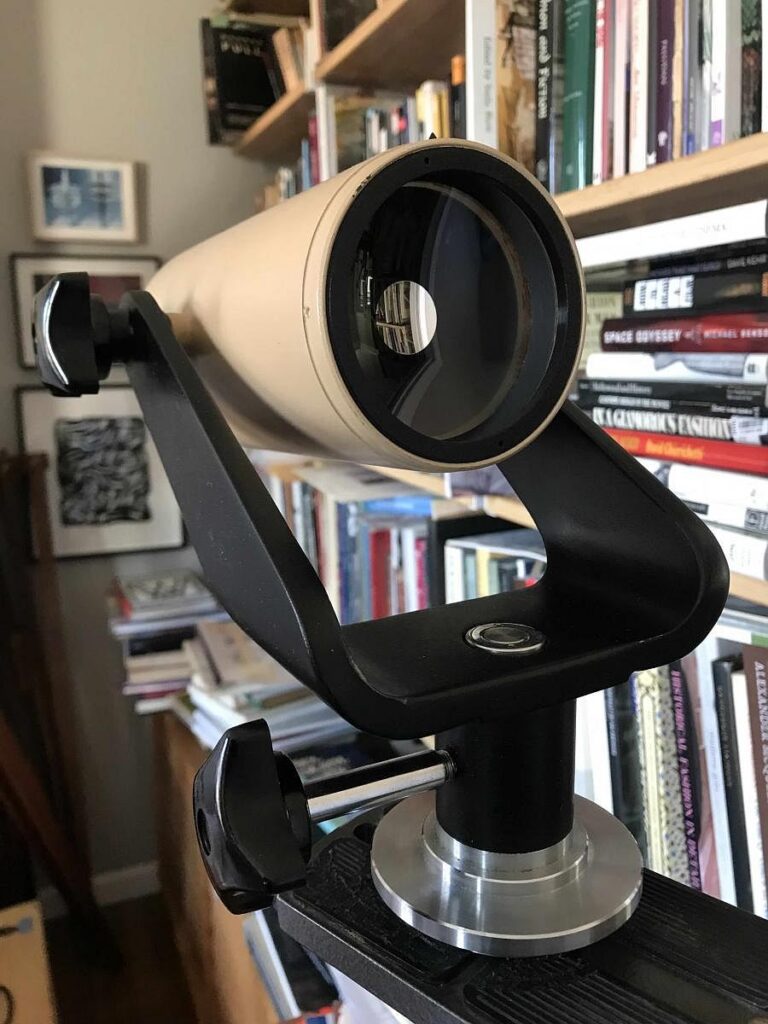
To summarize the information I managed to collect, the genealogy of PZO T50x70 seems to be as follows:
- Basic, early school version painted turquoise (starting from 1959)
- Turquoise export version „Celmak” with slow motion controls and finder
- Dark gray school version, also intended for export (second half of the 1960s, possibly early 1970s, serial numbers probably above 1.5 thousand, reaching over 2 thousand)
- Cream and black version with plastic screws (first half of the 1970s, perhaps 1973, until the early 1980s, serial numbers probably counted from zero, reach approximately 2.5 thousand)
- „Copernicus” export version
My estimates of dates and serial number ranges are uncertain and are based on photographic evidence available at the time of writing.
The double life of SA „Copernicus”…?
The attention that the authorities paid to the export of the T50x70 and the effort put into this sale may be surprising – especially if you compare it with the complete lack of interest in selling the telescope in the country. Marketing, packaging, distribution network… in the case of such a niche product?
Internal trade and exchange of goods between the Eastern Bloc countries were an economic fiction. It is true that exports to the West were the only source of „real” money from outside at that time. However, the scale of production and export of T50x70 was microscopic – in macroeconomic terms and from the state authorities point of view – practically non-existent. After almost 20 years, the profits from sales probably amounted to as low as several hundred thousand dollars… What was the purpose of this unclear undertaking, the costs of which also include sealing the embarrassing lack of any astronomical instrument on the Polish market? Or maybe it wasn’t about money at all?
I have no idea, although a basic calculator and a relatively sensitive nose are enough to realize that something is wrong here. Looking at the distribution network organized in Western countries, we will find the presence (at that time obligatory) of the so-called „foreign trade centrals” such as Varimex, which are known to have been infiltrated and used by the communist secret services as a cover for intelligence activities. If these questions are valid, it was the duty of officers placed in such institutions to ensure that we never knew the answers…


Poor man’s Questar looks up
Meanwhile, on the American market, the PZO product had to compete with the legend of Questar. These small Maks, produced in the USA since the 1950s, have gained a truly cult status there, and their prices reach thousands of dollars. I can’t rate them because I don’t have any personal experience with them. The fact remains that it is a brand positioned as absolute high-end, which is the subject of sighs and dreams in the USA.
It turns out that T50x70 is sometimes called „poor man’s Questar” in America – the term I encountered on one of the astronomy forums. Considering Questar’s extraordinary status, is this an ennoblement, or is it quite the opposite? Let’s note that the same term is used, for example, for the Meade ETX-90 – a beautifully made Mak with excellent, American optics and a captivating blue-metallic tube. Both telescopes are sometimes mentioned in discussions as an economical alternative to Questar and I have no doubt that this is a sign of appreciation for them.
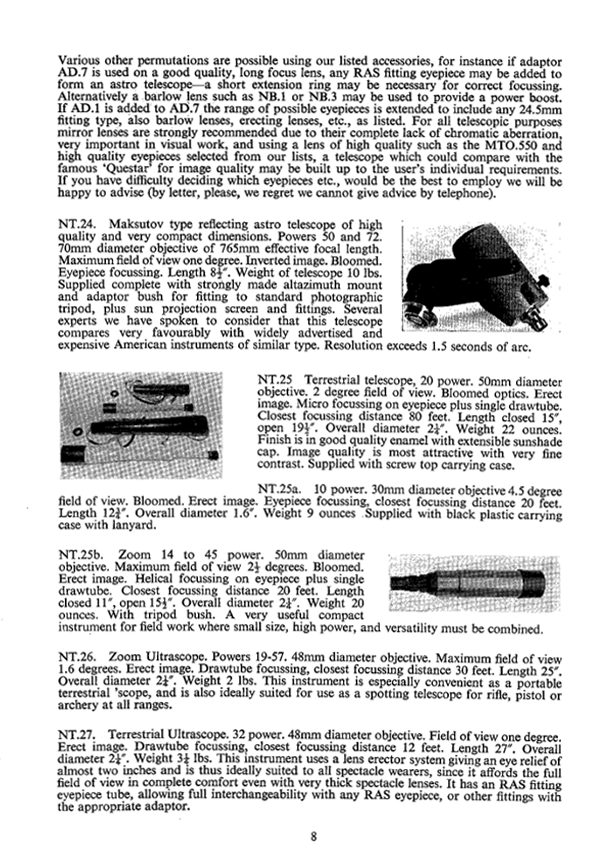
However, the term seems inaccurate in relation to the T50x70 as it ignores the context in which the instrument was designed. I paid a good deal of attention to the adventures related to starting production and attempts to get instruments for individual customers to show that the features and history of this telescope result from the decisions and capabilities of the manufacturer rather than from the expectations and capabilities of customers. If anything, it is rather a „poor manufacturer’s Questar„. Its simple, perhaps even somewhat crude design is a reflection of the rough technological realities in Poland at the turn of the 1950s and 1960s, when, on the wave of the „thaw” after 1956, the country tried to recover after the trauma of Stalinism.
The history of T50x70 is also the history of people who tried to create something valuable in these conditions – despite severe limitations, sometimes just because they saw such a chance. It seems that the creation of this telescope is an example of determination, which made it easier to raise a head at least for a moment in those difficult times. And to look up.
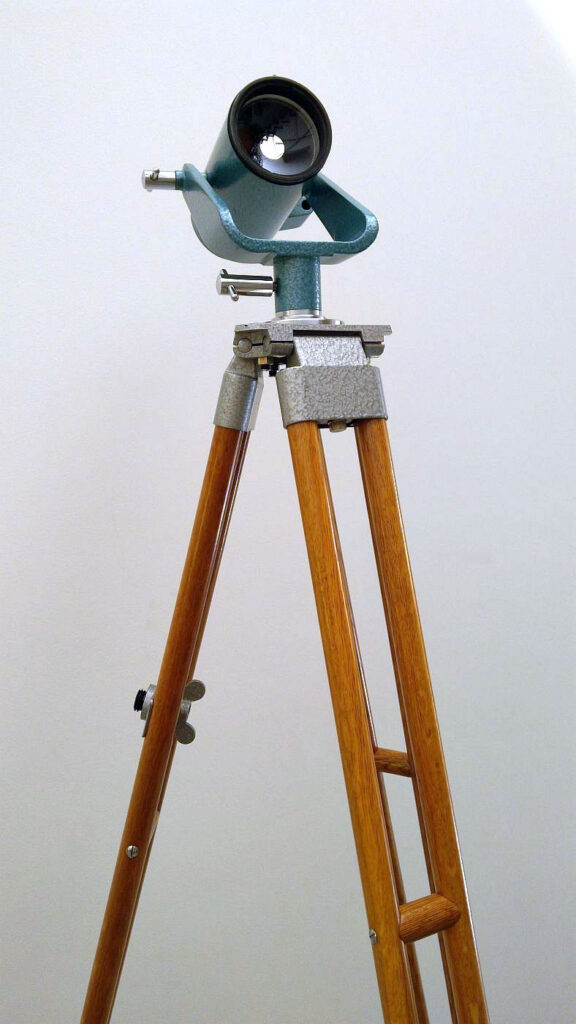
I would like to thank my colleagues from the CloudyNights.com and Astropolis.pl forums for their help and sharing extremely valuable illustrative materials:
– Artur Papaj (Astropolis.pl)
– Aurora (Astropolis.pl)
– Ben Bajorek (ColudyNights.com)
– Dave Trott (CloudyNights.com)
– Izonix (Astropolis.pl)
– Robert 'clamchip’ (Cloudynights.com)
– Steve_M_M (CloudyNights.com)
I also used illustrative materials from the National Digital Archives (nac.gov.pl), archives of the monthly Urania (urania.edu.pl), Wikipedia and TELESCOPE::Classics (wiki.telescopeclassics.com)
See also:
- PZO T50x70 – polski teleskop szkolny tysiąclecia – Polish version of this article
![]()